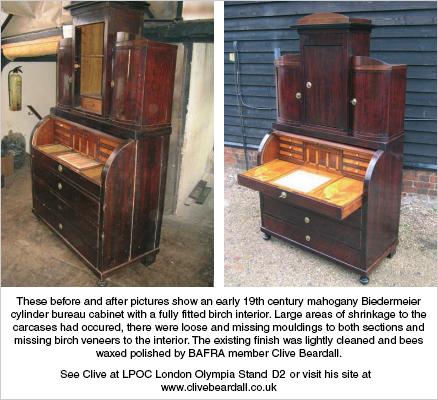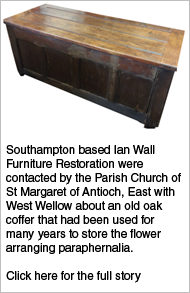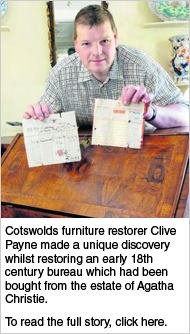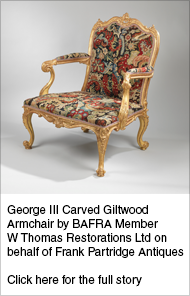Nearly four decades of maintaining standards
 For nearly four decades BAFRA has been ensuring that the heritage of antique furniture can be dealt with by the qualified, experienced and skilled craftsmen who have achieved accredited status within the organisation.
For nearly four decades BAFRA has been ensuring that the heritage of antique furniture can be dealt with by the qualified, experienced and skilled craftsmen who have achieved accredited status within the organisation.
With members situated around the UK they are able to offer a comprehensive service for the restoration and conservation of furniture and wooden artifacts. You can find a restorer near you HERE.
A strong and widely admired feature of BAFRA is the very wide range of skills practised by the membership, which covers every aspect of furniture design and conservation, historic interior woodwork, clocks, barometers, mechanical music, keyboard instruments, organs, marble and stone, textile conservation, leather, upholstery, metalwork, as well as every furniture decorative process such as carving, gilding, Japanning and oriental lacquer, and many more.
 Accredited members have all passed a rigorous assessment procedure which examines not only their bench and design skills, but also their artistic and business skills, integrity, historical knowledge of design, detailed construction techniques and conservation disciplines.
Accredited members have all passed a rigorous assessment procedure which examines not only their bench and design skills, but also their artistic and business skills, integrity, historical knowledge of design, detailed construction techniques and conservation disciplines.
Membership also extends to individuals who have yet to achieve accreditation and Friends of BAFRA who join to widen their interest and passion for antique furniture and related items in the moveable heritage.
Each member has to maintain the highest standards with BAFRA offering comprehensive complaints mediation services if this lapses at any time. Every member completes CPD (continuing professional development) to keep abreast of advances in knowledge, skills and technical developments.
BAFRA has close links with BADA (British Antique Dealers Association) and LAPADA (The Association of Arts and Antique Dealers) who are the principal antique dealers in the UK.
The promotion of study and research in furniture conservation and the advancement of public education in these fields is another important aspect of BAFRA. It has a comprehensive training schedule with additional training provided by its members.
Each year BAFRA publishes its own Members' Yearbook, containing details of every accredited member's skills and experience. This Yearbook is designed to be retained as reference material for anyone interested in furniture and the moveable heritage. Copies can be obtained from BAFRA head office.
You may ask: 'What is conservation compared to restoration?' Conservation is very closely allied to restoration and for the most part the skills of each go hand-in-hand. The key discipline in conservation is 'maintenance of object integrity' - i.e. the object's purpose and evidence of origin and natural ageing, both of which must be retained and protected.
The core discipline of conservation was founded by the museum world and since the early 1980s has been a central element of heritage discipline around the world. You can be assured that a BAFRA member is conscious of this distinction and will discuss all options with you.
Whatever your requirement, be it restoration or conservation, our members will be able to assist you. Our Head Office can be contacted on 01939 210826.
In January 2009, BAFRA, in conjunction with Regional Furniture Society and The Churches Conservation Trust prepared the following advice note on the routine care of historic furniture and fixed woodwork in churches. This article will be of particular interest to those in the church sector. BAFRA members would be pleased to assist with any enquiries regarding this particular aspect of restoration and conservation.
 The Routine Care of Historic Furniture and Fixed Woodwork in Churches
The Routine Care of Historic Furniture and Fixed Woodwork in Churches
Advice Note prepared by the Regional Furniture Society in association with BAFRA (British Antique Furniture Restorers’ Association) and The Churches Conservation Trust, January 2009.
Historic context
British churches contain some of the finest surviving examples of fixed woodwork and furniture in the country, in some cases dating back to the medieval period. They bear witness to centuries of devotion to God and chart the spiritual, cultural, social and political progression that has shaped the nature of worship in this country. They also reflect many aspects of national and regional identities.
Some of this woodwork has remained unchanged for up to a millennium, slowly wearing and mellowing through continual use whilst in other cases it has been moved or adapted, sometimes traumatically, as a result of changes in patterns of worship or the functions of the church.
The furniture and fixed woodwork surviving in churches is very likely to be of importance to the national heritage and should not be altered or removed without extremely careful consideration and preferably not before consulting a specialist in furniture history and/or conservation. For organisations which can provide impartial and expert advice, see the details at the bottom of this advice note.
First principles
Routine care of the surface finishes on historic furniture and fixed woodwork should not involve anything other than simple cleaning and dusting without professional advice. In almost all situations the wrong treatment of finishes is likely to cause more damage than no treatment at all, and in many instances no treatment is likely to be most suitable course of action. In the absence of damp, fungal growth or insect attack, most interior woodwork will survive indefinitely with little or no attention; if these problems are present, however, professional help is essential.
Woodwork in different situations and dating from different periods will have been finished in a variety of ways. On occasions the original finished surfaces will have remained unaltered, but more often they will have been re-finished and over-coated a number of times, leaving them with a complex patina. In this light there is no single ‘correct’ surface treatment for historic woodwork but hopefully the following guidelines will assist in avoiding the damage which can be caused by inappropriate measures, as has too often been the case in the past.
Surfaces should be dusted with a soft, lint-free cloth. For carved and moulded surfaces a soft brush can be used to gently flick dust into a vacuum nozzle. If surfaces have a wax finish this will usually be sufficient to restore it. In most cases there is no need to apply more wax, and in fact too much wax is likely to cause problems in the long run. If in doubt, leave the surface alone and simply dust it gently.
Waxing
Waxing will only be needed very occasionally, perhaps once in a few years, if at all. Only use a good quality, unstained beeswax with turpentine polish, such as Liberon Beeswax Paste (not to be confused with their Black Bison range of wax pastes). Avoid any beeswax polish which contains linseed oil, because it is added for ease of application but will not produce a hard, lasting surface. There is nothing to be gained from the excessive application of wax, most of which is either likely to be removed immediately when buffed up or remain as a tacky film to which dust will adhere.
Waxes containing silicone or aggressive chemical solvents must never be used, as they are likely to soften earlier treatments. Spray polishes are totally unsuitable and should never be used on early furniture or woodwork as some of the ingredients they contain can soften or damage historic finishes and patina.
Surfaces should be clean, dry and free of dust before waxing. Old furniture is sometimes dirty and greasy, and waxing over this can result in a sticky, smeared mess. Careful washing with a very mild solution of liquid soap, such as Teepol, a small area at a time and drying with a soft cloth, will remove this safely. Once the surface is completely dry, it can be lightly waxed as described above.
Careful consideration should be given as to which areas of furniture or woodwork might be appropriate for a waxed finish; in many cases a dry surface to the wood with little or no finish is perfectly acceptable, particularly on much early woodwork which was never intended to have a high glossy surface. If in doubt leave it alone, or consult an expert.
Oiling
The use of an oil of any description (Danish, Linseed, Tung, etc.) should be avoided and never undertaken without specialist advice. It is often resorted to as a quick and easy way to build up a finish on dry woodwork, but in many cases such a finish is not appropriate and oiling will darken woodwork in an ongoing and irreversible way. It will also attract dirt and dust, causing more cleaning problems in the future.
Over-coating
The application of further finishes over earlier treatments using anything other than beeswax as described above can lead to many problems. For example, solvents can permanently soften formerly stable surfaces and new finishes can ‘contract’ on drying and lift those beneath, or fail to adhere sufficiently and peel off, either immediately or after an apparently successful period of time.
If problems with incompatible finishes already exist, do not attempt to resolve them; they should only be tackled professionally.
Re-finishing
Stripping and re-finishing of any description is a major intervention which permanently removes historic finishes and changes the character and appearance of furniture and woodwork irrevocably. It is almost never justified, should only be considered as a last resort in exceptional circumstances and must only be undertaken professionally.
Abrasives
Never use abrasives of any description; sanding or scraping will destroy historic surfaces and can easily damage or remove detail such as carving and tool-marks. Wire wool must also be avoided; often used to ease the application of wax, it will ‘erode’ detail and unevenly cut through earlier finishes. It also leaves particles of steel embedded in the grain of the timber, and over time these react with timbers like oak, particularly if the atmosphere is at all damp. Abrasives of any kind should only be used professionally and in exceptional cases.
Do: dust lightly and gently with a lint-free cloth or fine brush
Do: occasionally and not more than once every few years, consider applying a light coat of beeswax with turpentine to surfaces which have been waxed before, but not to dry, unfinished woodwork
Don’t: apply wax to a surface which has not been waxed before; leave it as dry, unfinished woodwork
Don’t: use spray polishes, or any kind of silicone or chemical polish, or any solvents, because you will do more harm than good
Don’t: use oils of any kind
Don’t.: strip off the surface finish or use abrasives of any kind.
For a useful guide to good practice in the care of furniture and woodwork refer to The Manual of Good Housekeeping published by the National Trust.
If in doubt, do nothing, and call in an expert if you need advice.
For further information visit www.bafra.org.uk
To find a selection of BAFRA Members in your area check in the classified directory here















